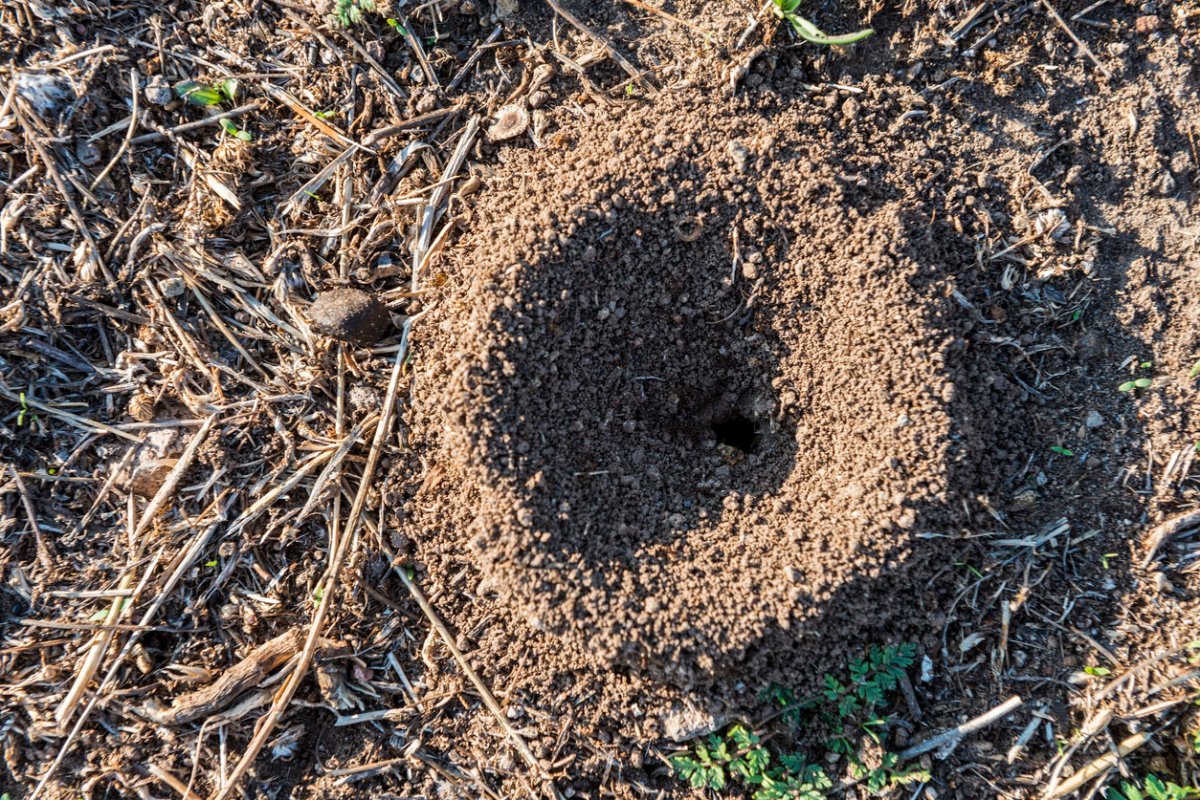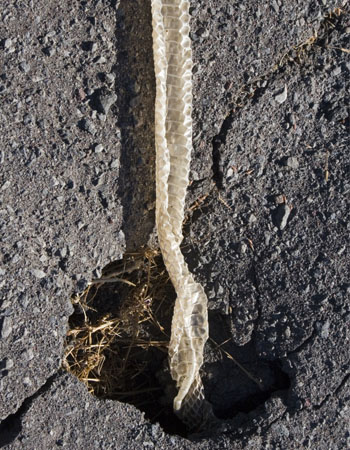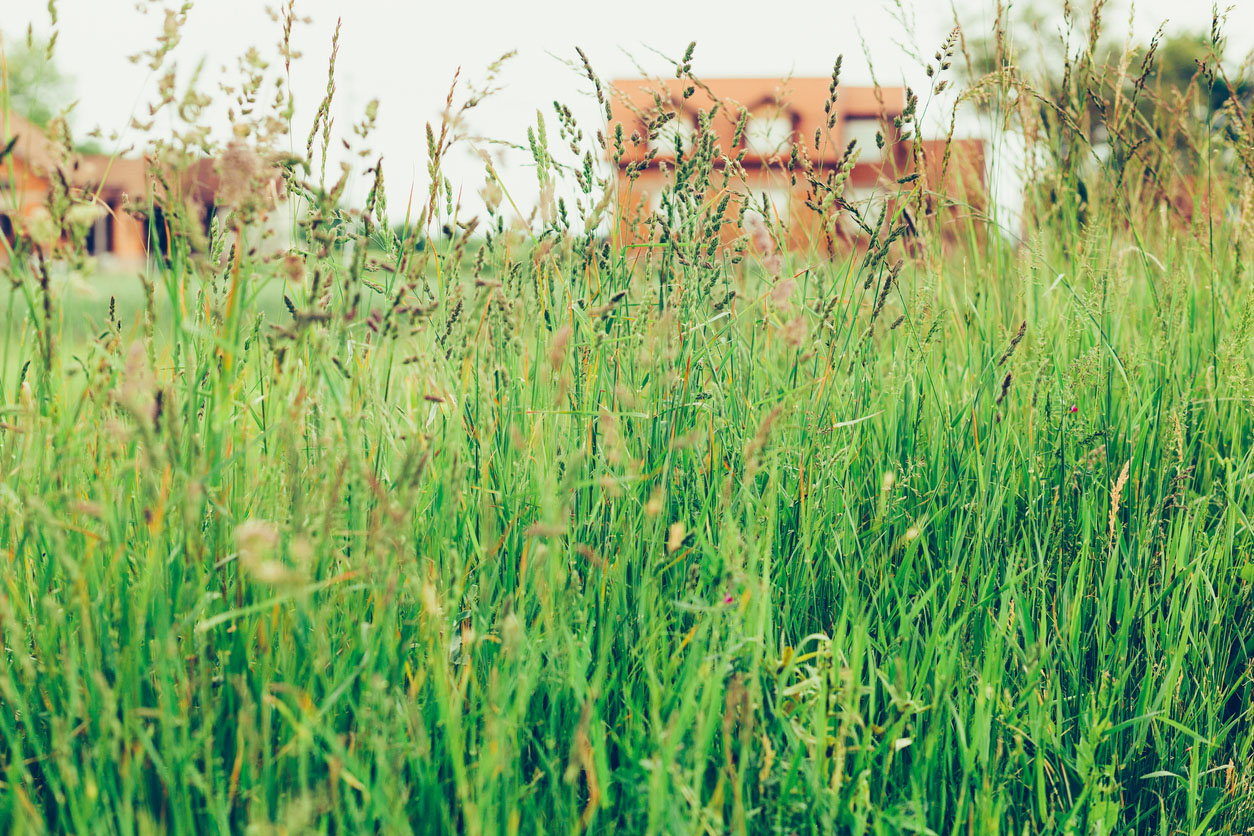

We may earn revenue from the products available on this page and participate in affiliate programs. Learn More ›
Q: While working outside, I noticed holes in the grass, and I’m concerned there may be snakes inside them. Do snakes dig holes? How can I tell if these are snake holes in the yard, and what should I do about them?
A: It’s common to hear holes in the yard referred to as “snake holes.” However, according to Andrew Christopher, owner and operator of Western Mass Wildlife Removal in Westfield, Massachusetts, “Snakes themselves generally don’t ‘dig’ holes. The way to best describe the species of burrowing snakes we have here in the U.S. is that they move very soft, sandy dirt and soils to cover themselves.”
Rodents and larger insects can also create holes in the ground that are perfect spaces for snake nests. These holes can be found embedded in grass, in piles of dirt or sand, or under piles of logs or sticks. Snake hole openings are circular but can range in diameter and depth due to the snake’s size.
There are a few things an individual can look out for that can help determine if there are (or were) snakes living in the hole. However, before dealing with any potential snake holes in the yard, it’s essential that they wear protective gear, such as gloves, to avoid getting bitten if any snakes are present. For those who prefer to keep their distance from snakes, it may be best to call a wildlife removal service as soon as the problem is identified.
Snakes can’t create holes in the yard, but they use holes dug by other animals as shelter.

Snakes may be able to form channels in soft dirt, but due to their anatomy, they are not able to dig holes. However, that doesn’t mean that they never live in them. “Snakes are opportunistic and enjoy taking over a burrow that was built by something like a vole, shrew, crawfish, chipmunk, or even tortoise,” explains Christopher. For this reason, finding snake holes may bring up additional questions about what animal is digging holes in the yard in the first place.
So what does a snake hole look like? Because the holes are created by a wide array of creatures, they can vary in size and shape. According to Christopher, “These holes can look like a small, almost perfectly round hole from the size of a quarter to up to a few inches (depending on what built it), or an angled oval-shaped hole leading into a burrow.”
Pictures of snake holes in yards typically depict round holes in the soil, as described by Christopher. However, rodent or insect burrows are not the only spaces a snake will inhabit. If no ground holes are readily available, Christopher points out that “they take advantage of other locations such as gaps between rock walls, spaces between concrete and other material on structures such as steps or cracks, so these are some other locations you can find snakes inhabiting.”
Look for nearby signs of snakes, like shed skins and feces.
It is challenging to assume a hole is from a snake without seeing a physical snake or signs near or around it. If there are no snakes in the hole when examined, it’s a good idea for the individual to check around the area for snake skins or feces. Looking closely at the skin can provide some clues about the snake’s size, shape, and activity level. This can help homeowners assess the situation and determine how many and what kinds of snakes they are dealing with.
To determine the presence of snake feces in the yard, homeowners can check for dark brown smears with a white end. The size of the feces correlates with the size of the snake—the larger the feces, the larger the snake. The placement of the feces can also reveal where the snake was recently active and, possibly, the general direction it traveled next.

Tried-and-True Advice
“When I first noticed a couple of small holes near my shed, I wasn’t sure if they were just old rodent burrows or if something (like a snake) was actually using them. I didn’t exactly want to stick my hand in there to find out. So I tried a simple trick: I sprinkled a light layer of flour around the holes and left it overnight.
The next morning, I checked for tracks, and sure enough, there were winding trails in the flour leading in and out of the holes. That confirmed something was still active down there, and I could even tell from the pattern that at least one of the visitors was slithering. It gave me a much better sense of what I was dealing with, without getting too close for comfort.
Now I use this little flour test anytime I spot a suspicious hole in the yard. It’s easy, safe, and surprisingly effective.”
—Paul Rankin, Contributing Writer and Editor
Identify the snake holes in your yard and determine whether they are vacant.
There may be more than one hole around the yard, so before deciding how to handle the one found, it’s a good idea for a homeowner to scout out areas where there may be piles of leaves, dirt, or sticks. Snakes or holes may be found under logs, and in any tall, grassy areas. If there are multiple, the snakes may be nesting in several holes or may have moved from one to another if there was a threat to their safety.
Once any snake holes have been identified, they can be examined carefully to see if the snakes are inside. It’s wise for a homeowner to wear gloves to avoid getting bitten by a potentially venomous snake. According to Christopher, “If a snake is living in one of these burrows, one of the best ways to tell is to observe the hole at the most common times, often mornings or afternoons. Snakes are cold-blooded, meaning they can’t produce their own body heat, and so they seek out the sun to bask when temps aren’t very hot, often outside of where they are living.” For a less invasive approach, cameras can be set up near the area to keep watch for any snakes that may move in and out of the hole over some time.
It’s worth becoming familiar with some common snakes in the area in case any are spotted. “Not being able to identify a species of snake can make an encounter scary, but most of the common species you’ll encounter … are harmless to us even if they look big and scary,” Christopher says. “Getting proper identification skills is a great way to allow yourself to feel safe in a situation with a snake.” Identification can also make it clear when it’s time to bring in a professional to help with getting rid of rattlesnakes or other threatening species. Some of the most common yard snakes in North America are:
- Common kingsnakes: This kind of snake has striking black-and-white stripes and can be anywhere from 2 to 6 feet long. While these snakes may bite if they feel threatened, they are not venomous.
- Cottonmouths (also called water moccasins): Cottonmouths can be identified by their triangle-shaped head, dark green or black coloring, and dark-colored crossbands. They reach up to 4 feet in length but have larger bodies than other similar varieties. This species is venomous.
- Garter snakes: These snakes are nonvenomous and are even considered beneficial by some as they eat a variety of pests. They are typically less than 2 feet long with a few yellow stripes running down the length of their bodies.
- Northern water snakes: This snake, sometimes misidentified as a cottonmouth, is not venomous. About 24 to 42 inches long, its spots range from dark brown to black. While they are typically found near the water, they will migrate to drier climates to hibernate, which is why they may be found in relatively dry yards.
- Rat snakes: Rat snakes are shiny and black and can reach up to 6 feet in length. They are not venomous but may strike or bite if they perceive a threat. Since this type of snake can climb, it is not uncommon to find them in trees.
- Redbelly snakes: These snakes are considered to be completely harmless. Alongside their characteristic red underside, they can be identified by their slim bodies, which only grow to about 10 inches in length.
Leave the snake hole alone.
Most likely, the snakes found in the yard will not be venomous. The non-venomous snakes help eliminate insects like crickets, certain types of worms, and cockroaches. They also will feast on pests like rats and moles. In most cases, it is beneficial to let the snake continue going about its business. However, if the snake becomes a bother or threat to any person or pet, there are ways to get them to stay away. These include purchasing snake repellent for yards, planting snake-repellent plants, setting traps, and filling or covering snake holes.
Cover a snake hole in the yard with dirt, netting, wire, or burlap.
Snakes prefer holes that offer a dark, cool space to slither into. The holes can protect them and help them catch prey. Before doing anything with a snake hole, the homeowner will want to make sure it is not occupied. According to Christopher, “If there is a snake or snakes currently inside a burrow structure or a hole, and you cover it up and they cannot escape, they will become trapped and die. That isn’t always a great idea when you aren’t sure what’s going in and out.” If there are nesting snakes and they are disturbed, they may become irritated and bite. It’s wise to exercise safety by wearing gloves and keeping an eye out for any snakes in the immediate area.
For those wondering what to pour down a snake hole, in many cases the best answer is dirt. “A hole in the ground could be simply filled in with dirt if there isn’t any sign of anything going in and out, and as long as the ground is fairly hard packed, snakes can’t reopen or re-dig a new hole,” says Christopher. Other material options include netting, wire, or burlap. The key point to remember if deciding to fill or cover the hole is not to pile up material, as this will create the perfect space for snakes to nest there again. Homeowners will want to make sure the filling or covering is flat or as level as possible with the ground. Eliminating the hole will drive snakes elsewhere to nest and find food.
Take caution when working around snake holes, and check your local regulations.
It’s a common reaction to want to act aggressively against a snake out of fear; however, regulations may need to be considered before taking action. Some states have laws prohibiting shooting or hitting snakes. It’s important for homeowners to also check if fumigation is a legal option.
There are several options for snake removal, one being the use of one of the best snake repellents for yards. The repellent can be sprayed where snakes are spotted and at the edges of the yard to keep them out. They often take on a scent of cinnamon, clove, or ammonia. Homeowners will want to find repellents that are safe for humans and pets, as well as ensure it’s legal in the local area.
Another option for getting rid of snakes is setting a humane snake trap. It won’t kill the snakes but will trap them so they can be released later on. Homeowners will want to be careful when working around the snake holes and using traps because the snakes may become agitated and try to bite once released. They’ll want to wear protective gloves to avoid getting harmed. If a snake gets trapped, it will need to be released at least 10 miles from where it got trapped to ensure it doesn’t end up back in the yard.

Eliminate hiding places and food sources to make your yard less hospitable to snakes and their prey.
The perfect environment for snakes to thrive in has tall grassy areas with large piles of dirt, leaves, or sticks. These environments are populated with insects and small rodents. Snakes will continue to stick around areas they know have food for them to eat; thus, it’s important for homeowners to eliminate their food sources.
According to Christopher, “Habitat modification is one of the biggest things we preach, and that can involve eliminating thick shrubbery for them to be able to hide in, eliminate overbearing rodent problems, and have areas you don’t specifically want them to enter sealed tightly (such as the house, garage, shed, etc).” Some simple approaches include removing any piles in the yard where rodents or insects may live, burning firewood before springtime, leveling out piles of dirt, and clearing out leaves. The other option is to drive out rodents by using traps or smoking them out of the yard. Smoke bombs can be used, but homeowners will want to be careful not to use them in areas with lots of trees, a wooden porch or furniture, and other flammable structures.
Call a wildlife control professional to help get rid of snakes and keep them away.
Snakes can be harmful to people or pets if they feel threatened or become irritated, even if they are not venomous. If there is any hesitancy when encountering the snakes or in knowing the best way to handle snake holes, it would be best for a homeowner to look up “snake removal near me” and let a professional handle the problem. Not only will this help keep homeowners and their families safe, but it can also reduce the harm to wildlife. “Generally, snakes in the yard aren’t a threat to homeowners unless you are dealing with repeated encounters with venomous species,” says Christopher. “I myself am from the Northeast in Massachusetts and we only have two venomous species, the timber rattlesnake and northern copperhead … In the South and West, it can be a little bit more common to come across venomous species in more common locations, so we recommend contacting a professional to first identify the species and then put together a plan for a safe way to eliminate the issue.”
In most cases, wildlife removal costs about $189 to $573. For those who are unsure of who to call for snake removal, exterminators or local wildlife services can remove snakes from the property safely and humanely. They’ll be able to assess the risks and provide the best solution to creating a yard free of snakes. They can also educate homeowners on what types of snakes are inhabiting their yards and tips on how to avoid future infestations.
